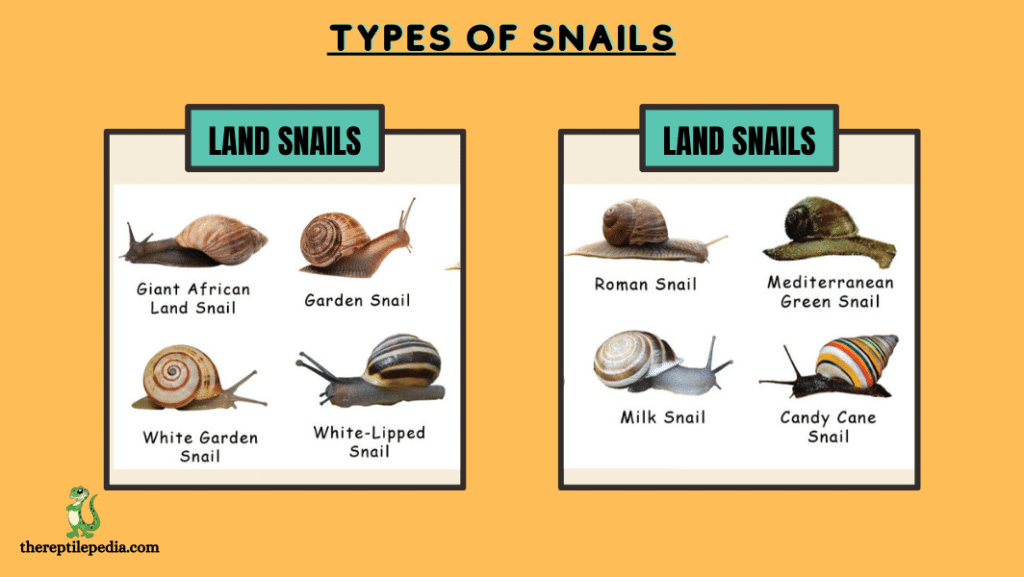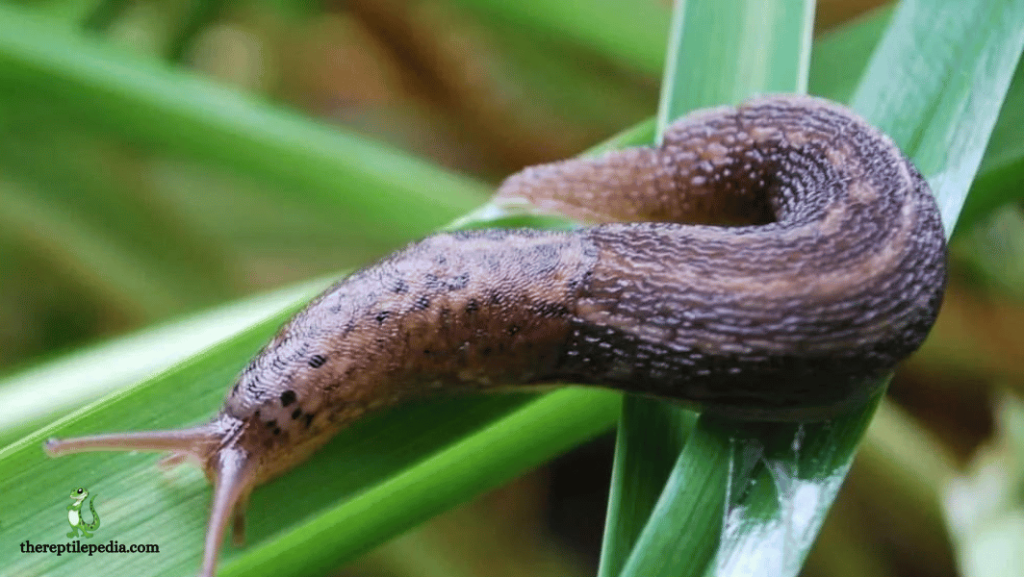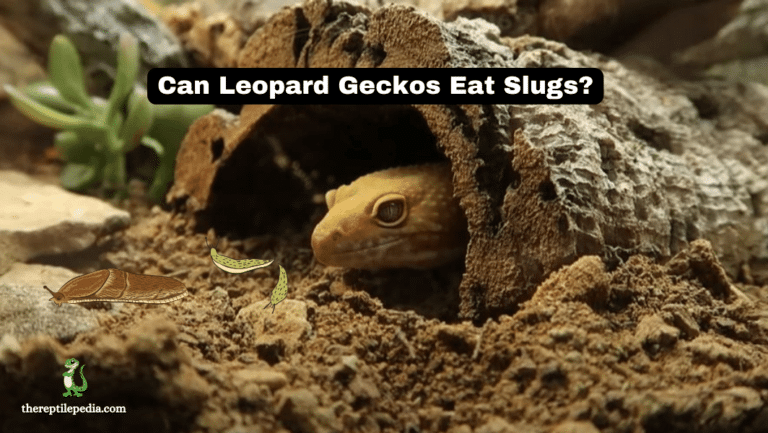Are you wondering if it’s okay to feed slugs to your leopard gecko? It’s a question many gecko owners have. In this article, we’re going to look at why slugs might not be the best food choice for your little buddy. Leopard geckos usually eat bugs, and their bodies are used to that kind of food. We’ll talk about the risks of giving them slugs, like bad germs and not getting the right nutrients. Plus, we’ll share some better food options to keep your gecko happy and healthy. Stick with us to learn how to make mealtime safe and yummy for your gecko!
Table of Contents
Can Leopard Geckos Eat Slugs and Snails?
Adding a variety to your leo’s diet with a few servings of slugs or snails can offer your pet several nutritional benefits. These mollusks are low in fat and high in protein. This nutrient offers several advantages, including muscle development, efficient metabolism, and immune system support.
While slugs are not ideal as staple food for Leopard Geckos, they can be a great addition to your pet’s diet. They can provide a rich source of iron, calcium, and phosphorus. However, you should always be sure to feed your Leopard Geckos slugs that have been fed well and are free of any parasites or toxins. Slugs also possess a sticky slime that can present choking hazards for your pet, so they should be avoided if possible.
Several reasons why Leopard Geckos should not eat slugs
Slug size
From personal experience and expertise in reptile care, I’ve learned that the size of the food plays a significant role in what is safe and healthy for them to consume. Slugs, for instance, often exceed the average 1.2 to 2 inches in length, with some varieties reaching up to 4 to 8 inches. This far surpasses the space between a gecko’s eyes, which is a good rule of thumb to use when determining the maximum size of their feed.
Customarily, a healthy Leopard Gecko will prefer a selection of insects and worms that are considerably smaller, making slugs a less-than-ideal choice. The staple diet of these geckos should consist of prey that they can easily manage, ensuring their well-being and health remain optimal.
Slug Mucus and Taste
When contemplating Leopard Geckos’ diet, special attention should be given to the mucus produced by slugs. From my extensive experience in reptile care, I’ve noted that the slimy secretions, a blend of mucous and serotonin, can potentially introduce toxic elements to Leopard Geckos. This mucus is not just challenging for the geckos to pick up and hold due to its slippery nature, but it also presents a significant choking hazard.
Moreover, in the absence of a protective shell, these secretions could lead to poisonous outcomes or create foul taste experiences for the geckos, deterring them from the prey. Therefore, it is wise for caregivers to avoid feeding slugs to Leopard Geckos, prioritizing their pets’ health and safety above the need for dietary diversity.
Risk of Skin Irritation from Slugs
In the intricate world of Leopard Geckos, the consideration of slugs as a food source brings to light a less-discussed concern: skin irritation. Drawing from my own journey in herpetology, I’ve come to understand that the unique radula of slugs, with its 27,000 microscopic teeth, designed to nibble and grind their food, poses a serious risk when it comes in contact with the delicate skin of Leopard Geckos. These teeth, while not typically used to bite in a defensive manner, can still irritate or potentially damage the gecko’s skin through dragging or rubbing actions as the slug moves.
Additionally, the slimy secretion, which slugs use for suction to the ground, can further injure the gecko’s skin upon contact. This discovery leads to a surprising realization that, despite their harmless appearance, slugs can seriously irritate or even harm Leopard Geckos, making them an unsuitable choice for a gecko’s diet.
Threat of Slug Toxicity
When assessing the suitability of slugs as food for Leopard Geckos, the lurking toxicity risk must not be overlooked. In my journey with reptile care, I’ve encountered numerous instances where slugs, though seemingly harmless, carried dangerous levels of toxins. These creatures often consume poisonous plants and mushrooms, or come into contact with pesticides and chemicals used in gardening and agricultural settings. Such toxic substances, when ingested by Leopard Geckos, can pose a serious health risk, leading to severe illness or even lethality.
The risk is amplified by slugs being notorious scavengers, carrying these substances on their bodies as they pass by vegetables, fruits, and other greens that have been sprayed. Given these factors, it becomes clear why feeding slugs to Leopard Geckos is a gamble with their health, making it a decidedly unwanted option for their diet.
Nutritional Needs: The Case Against Slugs
While slugs might seem like a good source of nutrition with their low fat and high protein content, they fall short when it comes to the specific dietary needs of a Leopard Gecko. Through my hands-on experience in reptile nutrition, I’ve learned that what works in the wild doesn’t always translate well to captive care. Slugs do offer proteins, amino acids, and minerals like calcium and iron, which are essential for healthy gecko growth. However, they also come with a significant risk of parasites and toxins, which greatly outweighs their potential benefits.
Moreover, slugs and snails might not provide the necessary vitamins and movement stimulation that Leopard Geckos derive from hunting live insects and worms. Even though canned options exist, they lack the gut-loaded supplements and beneficial variety that makes up the best dietary options for these reptiles. It’s advisable to stick to a diet that mirrors their natural prey, ensuring your gecko remains terrifically vibrant and healthy.
Not a natural food source
In the reptile community, it’s well known that a diet that closely replicates what Leopard Geckos would consume in the wild is not just beneficial but advantageous for their health. However, slugs and snails, typically found in cool, dark environments, are far from the arid, hot, and dry climate these geckos originate from. This stark difference in natural habitats means that slugs are not a food source Leopard Geckos would easily find or enjoy eating in their natural setting.
Feeding them slugs goes against their instinctive feeding habits, potentially disrupting their nutritional balance and beneficial dietary practices. It’s essential to tailor their diet to include similar environments and prey items they would naturally encounter, ensuring their captivity diet mirrors their wild origins as closely as possible for their well-being.
Types of Slugs and Snails

- The Garden Slug (Arion hortensis) is often found in close proximity to human habitation, particularly in gardens and agricultural spaces. These slugs are relatively small to medium in size and are recognized by their dark color. They have a particular penchant for garden vegetation, which can lead to significant damage to plants.
- The Banana Slug (Ariolimax dolichophallus), known for its impressive size and bright yellow coloring, inhabits the moist, forested areas of the Pacific Northwest. This slug plays a vital role in the decomposition of dead organic matter, thus contributing to the nutrient cycle within its ecosystem.
- Across the European landscapes, the Roman Snail (Helix pomatia) is distinguished by its robust, spiraled shell, which displays a pattern of white or cream with brown stripes. Beyond its ecological presence, this snail is esteemed in culinary circles, particularly in France where it’s savored as “escargot.”
- The Black Slug (Arion ater) showcases a remarkable adaptability, inhabiting a wide array of environments from gardens to forests. This slug can vary in color from black to orange or red, and its robust nature allows it to thrive in diverse climates.
- Urban areas often play host to the Great Grey Slug (Limax maximus), notable for its size, grey color, and distinctive spots. This slug is unique for its predatory habits, feeding on other slugs, which aids in controlling pest populations in gardens and cellars.
- The Common Garden Snail (Cornu aspersum) is ubiquitous in gardens, parks, and agricultural fields, easily recognized by its medium-sized, brownish shell with yellow stripes or bands. While it consumes a broad range of plant materials, it’s often deemed a pest due to the damage it can cause to vegetation.
Benefits of Feeding Slugs and Snails to Leopard Geckos

1. Nutritional Variety:
- Diverse Diet: Incorporating slugs and snails into the diet of Leopard Geckos can provide a change from their regular insect-based meals, potentially enriching their overall nutritional intake.
- Natural Prey Simulation: Offering slugs and snails can mimic the variety of prey Leopard Geckos might encounter in the wild, contributing to a more naturalistic diet.
2. Hydration Boost:
- Moisture Content: Slugs and snails have a high moisture content, which can help in hydrating Leopard Geckos, especially beneficial for those that might be reluctant to drink standing water.
3. Enrichment and Hunting Stimulation:
- Behavioral Enrichment: The process of hunting and consuming live slugs and snails can provide mental and physical stimulation, promoting natural hunting behaviors and enhancing overall well-being.
- Sensory Stimulation: The unique textures and movements of slugs and snails can offer sensory enrichment, encouraging Leopard Geckos to engage more with their environment.
4. Potential Nutritional Benefits:
- Protein and Low Fat: Slugs and snails are sources of protein and have low fat content, which can be a healthy addition to the gecko’s diet in moderation.
- Minerals: They can also provide essential minerals such as calcium and magnesium, contributing to bone health and overall physiological functions.
5. Soft Prey Option for Delicate Eaters:
- Gentle on Digestion: For Leopard Geckos with dental or digestive issues, the soft bodies of slugs and snails can be easier to chew and digest compared to harder-shelled or tougher insects.
6. Precautions and Recommendations:
- Parasite Risk Mitigation: It’s crucial to source slugs and snails from safe, parasite-free environments or consider captive-bred options to minimize health risks.
- Moderation and Variety: Slugs and snails should only be a part of a varied diet, not the sole food source, to ensure balanced nutrition.
- Observation: Always monitor your Leopard Gecko’s reaction to new food items and consult with a reptile veterinarian for personalized dietary advice.
ALSO READ: Can Leopard Geckos Eat Stink Bugs?
Dietary needs of Leopard Geckos
| Aspect | Details |
| Varied Diet | Paramount for health, akin to human dietary diversity. |
| Prey Selection | Insects (crickets, mealworms, roaches), worms (earthworms, waxworms) preferred. |
| Nutritional Balance | Essential vitamins and minerals needed to avoid deficiencies. |
| Occasional Treats | Small mice suitable for adult geckos, offered rarely. |
| Amphibian Caution | Possible option but with potential risks; use sparingly. |
| Slugs and Snails | Not recommended due to potential lack of necessary nutrition. |
Final Thoughts
It is important to note that slugs and snails should only be offered as occasional treats. They do not provide the essential nutrition that your Leopard Geckos require, and are more of a choking hazard than an actual meal for these reptiles. In addition, the indigestible chitin that makes up their shells can cause gastrointestinal problems and blockages. To avoid this, you should only offer slugs and snails to your geckos after they have been soaked in a liquid that is high in calcium, such as water with a splash of apple cider vinegar. The acetic acid in the vinegar will break down the chitin and make it easier for your Leopard Geckos to digest them.
FAQs:
What insects can leopard geckos not eat?
Leopard geckos should avoid eating fireflies, boxelder bugs, and wild-caught insects, which may carry pesticides or parasites. Also, avoid insects with hard exoskeletons like mature mealworms, as they can cause impaction. Stick to captive-bred prey suitable for their size to ensure a safe, nutritious diet. Always consult with a vet for the best dietary advice for your gecko.
What is toxic to leopard geckos?
Leopard geckos are sensitive to chemicals and should not be exposed to insecticides, pesticides, or household cleaners. Foods like avocados, onions, garlic, and chocolate are toxic to them. Additionally, avoid feeding them wild insects, which may harbor harmful parasites or pesticides. For optimal health, provide a diet of gut-loaded, calcium-dusted insects and a habitat free of toxic substances. Always consult a veterinarian for specific care advice.

